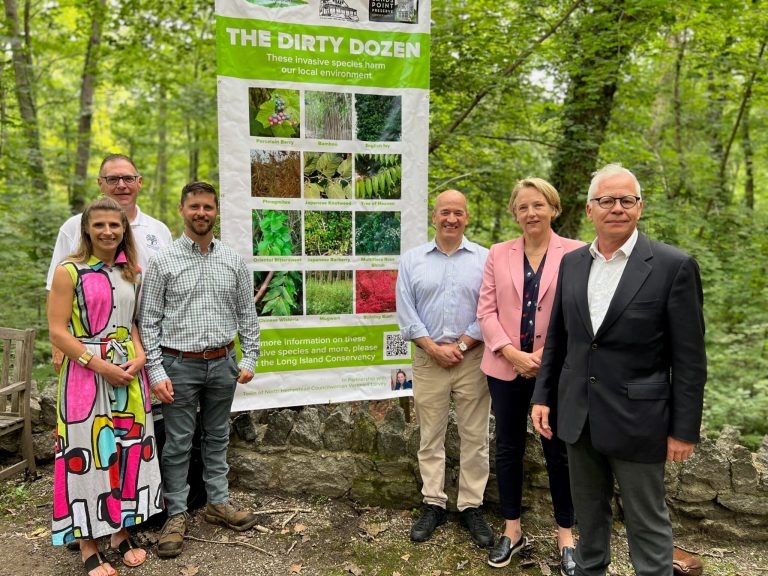
Sands Point Preserve, a serene 216-acre expanse nestled in Sands Point, is confronting a growing threat – invasive species. The natural haven, with its diverse landscapes encompassing forests, lawns and gardens, has fallen prey to these unwelcome intruders, jeopardizing not only the preserve but also the broader ecological balance of Long Island.
On Aug. 28, representatives from local environmental organizations, including the Long Island Conservancy, Sands Point Preserve Conservancy and the Science Museum of Long Island, gathered beneath the preserve’s canopy of trees to raise awareness about the invasive species menace. North Hempstead Town Council Member Veronica Lurvey joined them in this endeavor.
“Invasive species disrupt the delicate harmony of our natural spaces in multifaceted ways,” emphasized Marshall Brown, executive director of the Long Island Conservancy. “Beyond competing with native flora for vital resources, these interlopers can harbor harmful insects like the spotted lanternfly, exacerbating ecological imbalances.”
At the heart of concern lie the “Dirty Dozen” – a formidable collection of 12 invasive species, including Porcelain Berry, Bamboo, English Ivy, Phragmites, Japanese Knotweed, Tree of Heaven, Oriental Bittersweet, Japanese Barberry, Multiflora Rose Shrub, Chinese Wisteria, Mugwort, and Burning Bush.
These invaders demonstrate resilience, outcompeting native plants for essential resources such as water, nutrients, and sunlight. Their presence also leads to the formation of ecological dead zones, as native wildlife remains ill-equipped to consume them, resulting in a diminished support system for the diverse ecosystem typically found in native forests.
“Here, within the embrace of Sands Point Preserve’s green expanse, we are entrusted with a sanctuary that exemplifies harmonious co-existence,” said Jeremiah Bosgang, executive director of the Sands Point Preserve Conservancy. “It is our hope that this shared haven will inspire vigilance among our guests, compelling them to recognize and manage these invasive species with the respect nature deserves.”
The Science Museum of Long Island, established in 1962, is committed to nurturing curiosity in the younger generation through educational programming. Hildur Pálsdóttir, president of the Science Museum of Long Island Board and a Blank Slate Media columnist, underscored the importance of collaboration.
“We extend our gratitude to Council Member Veronica Lurvey for aligning with the Science Museum of Long Island and our environmental comrades to amplify this crucial message,” Pálsdóttir said, “Through partnership, we aim to combat invasive species while nurturing the native flora that imbues our grounds.”
Frank Piccininni, partner and co-founder of Spadefoot Design and Construction, lent his support, highlighting the significance of sustainable landscaping practices.
“As champions of sustainable landscaping practices on Long Island, we recognize the importance of reclaiming our environment from invasive species, fostering the revival of the island’s ecosystem,” he said. “Working hand in hand with Council Member Lurvey and our environmental partners is an honor as we strive to illuminate this vital regional issue.”
Veronica Lurvey, North Hempstead Town Council member, reflected on the delicate tapestry of Long Island’s environment, emphasizing the need for collective action.
“The allure of Long Island’s natural grandeur is undeniable,” she said, “and as stewards of this land, it’s imperative that we stand together to protect it. Gratitude goes to our allies—the Long Island Conservancy, Sands Point Preserve Conservancy, and the Science Museum of Long Island—for their unwavering commitment to enlightenment.”
For more information about the “Dirty Dozen” and efforts to combat invasive species, visit the Long Island Conservancy’s website at www.longislandconservancy.org.






